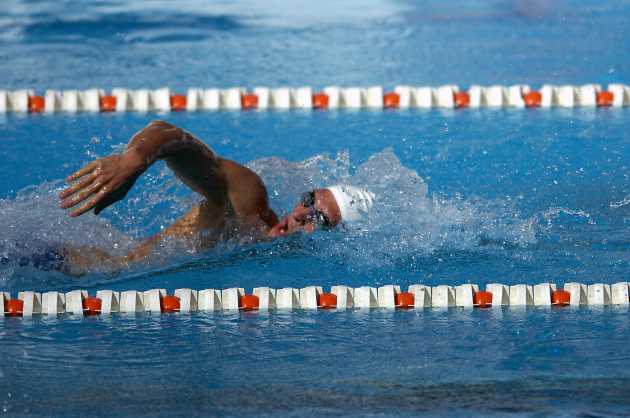How Do You Not Get Tired When Swimming Fast?
On the web, you will find so many references about how to swim faster. However, in this blog, I like to bring you the smallest details, because, as they say, the devil is in the details.
Therefore, I shall show you actionable tips on how to swim like a fish, without the need to rest and recover your breath too often.
So, how to swim faster without getting tired (too soon), is possible. Of course, since swimming is an energy-intensive exercise, you will feel tired, but there is a way you can avoid feeling it too soon.
1. Eat something before swimming

Swimming burns calories, and unless you want to lose weight, you need to eat something before swimming.
The good thing is that you don’t have to wait 30 minutes after eating to swim. Well, you can eat first, then prepare for swimming by showering and getting into your swimsuit, but there is no need to wait 30 or 60 minutes.
Depending on how long you intend to stay in the water, you can take a calorie-packed snack before swimming.
This is going to give you the energy that you need to keep going.
Also read my post on: Swimming with a yeast infection
2. Hydrate well before swimming
Many people do not know this, but when you swim, you sweat, and you lose water. Also, because of the cold temperature of the water, your body will be fighting extra hard to keep warm. Combined with the sweating and the water loss, you can get tired really fast.
If you are swimming in the open water, and it will take longer than 30 minutes, carry a water bottle with you. When swimming in the pool, you can just take breaks and rehydrate.
Drink water before you get into the water. Also, stay keen because after 20 or so minutes, you might feel the urge to urinate while swimming. This comes from the water you drank, as well as from the buoyancy.
3. Reduce drag in the water
Drag is a real speed killer, and it adds extra weight that you have to haul along. Drag comes from wearing baggy swimming attire for men, or women.
There is a reason why the best swimming attire fits like a second skin. However, even in the case of some loose-fitting swimsuits like tankinis, they are so thin. They do not absorb too much water, so they create minimal drag.
When swimming in the ocean, keeping warm is a concern. Therefore, you can wear a wetsuit for swimming. In addition to keeping you warm, it improves aerodynamics, improving your swimming speed.
If you have long hair, do not let it loose while swimming, because it creates drag. Again, no one wants to see your hair trailing behind you in the pool. To prevent this, please wear a swimming cap.
Also, wear one when you are swimming in the ocean because it can keep your head warm. You can choose a latex or silicone swimming cap.
4. Learn how to breathe properly
Knowing the exact moments to breathe in and out when swimming is critical, and it can hamper your swimming speed a great deal.
Simply, the most essential thing is to breathe out when swimming underwater, that is, when your face is underwater.
When the face is out of the water, you can breathe in, and hold the air in your lungs. Timing is everything because you need to breathe in as much air as possible before starting the stroke cycle.
Also check: Swimming underwater without holding your nose
You need oxygen to power your swimming stroke. Since your face will be in and out of the water, time your breathing to the time it is out of the water.
Do not lift your head off the surface of the water to swim. If you do this, your legs will sink, and this will create more drag in the water.
Also, if you are breathing bilaterally, do not rotate too far. This can interfere with your posture, and slow your progress.
Inhaling enough oxygen can keep you swimming longer and harder.
5. Use the freestyle swimming technique

Out of the five basic swimming styles, freestyle is the best of them all. It is easy, it is simple to execute, and it does not consume a lot of energy.
In the freestyle technique of swimming, it is easier to keep swimming forward using the least motion. Also, the body can move through the water with the least water resistance.
Beginners will find it a bit hard to keep a proper stance when swimming using this style. The idea is to keep the head and the hips aligned all the time. This gives you a more streamlined posture that can slice through the water easily.
To make the stroke, you need to extend your arms forward, over your head. However, do not create a wide circle with the arms.
Rather, keep them as close to your body as possible when extending them and pulling them back. If you do this, you will maintain a streamlined posture, which will make you swim easily.
It takes the arms and the legs to propel yourself in the water. In this case, you need to keep your hands moving as close to your body as possible.
It creates a cyclic motion, as opposed to flapping. Remember, flapping increases drag, and consumes more energy.
When kicking the legs, keep them close, at hip-width, and only kick when you must. When you kick too much, you slow your progress, and you become tired too soon.
6. Follow a good swimming guide
If you are aiming for speed and distance, you need to follow a good plan. That way, you will not be swimming blindly.
Another benefit of following a good plan is that you can track your progress. If you are swimming in the pool, you can count the number of laps, and the time it takes you to swim.
If you are swimming in the ocean, you should know how long you need to swim, so that you don’t go too far out.
Perhaps you are training for a triathlon, you will need to know what areas to improve your swimming technique.
You need to track your progress. If you swim 30 minutes today, you can aim for 45 minutes after a couple of days. Every improvement that you make is good, because it will lead to more progress in the future.
Some of your key performance indicators while aiming to improve speed and distance include how many laps you can do in the shortest time possible.
Also check these articles:
Results of swimming 3 times a week
Benefits of swimming daily for a month
Swimming in the ocean with a herpes outbreak
Wrapping it up
After you learn how to swim on your own, the next thing you will want to do is to build your speed and endurance.
The good thing is that this is not too hard. You can follow all the tips I have shared here to make faster progress.
It starts with the basics, such as wearing a two-piece swimsuit, or a wetsuit. This will reduce drag and give you better aerodynamics in the water.
Be patient. You will not build your swimming speed and stamina overnight. Be easy on yourself, and keep working.
